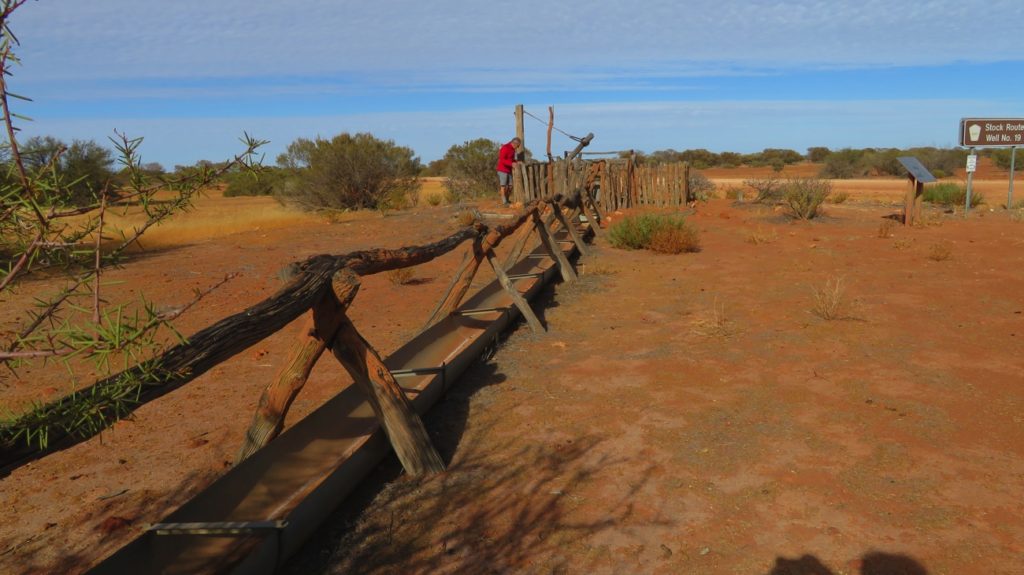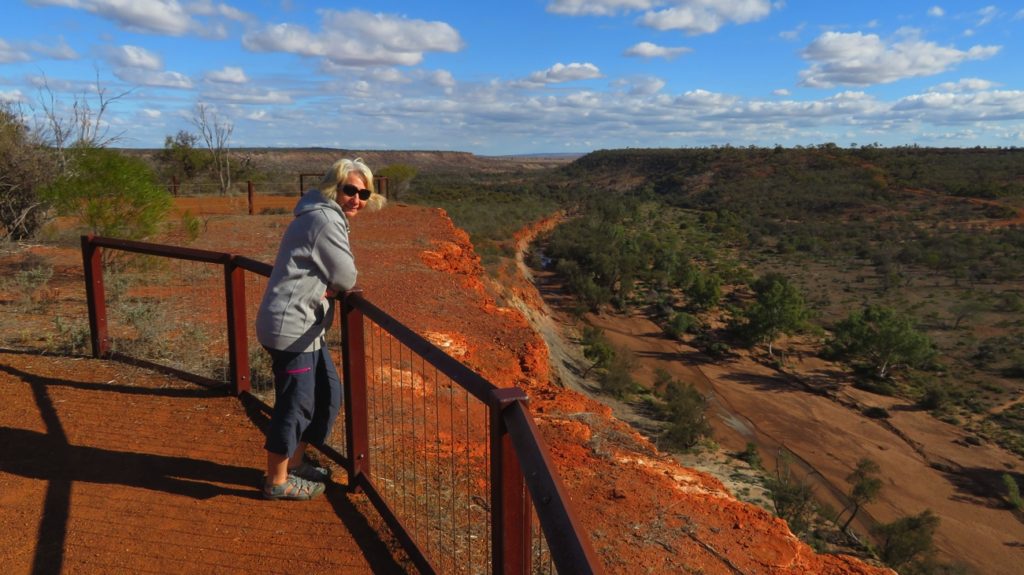6th – 8th July, 2017
Thursday 6th
We’re heading south now on the unsealed Carnarvon-Mullewa Road with purpose – to meet up with our daughter and granddaughter in Perth next week.

The countryside through which we travelled. This photo is taken right beside Bilung Pool.
The few cattle we saw on this arid-looking country looked in surprisingly good condition. Few cars passed us and we went through no towns before stopping for the day at Bilung Pool, with only two other campers. This lovely permanent waterhole is quite a surprise appearing from nowhere in this featureless country, surrounded by large old River Redgums. It’s about 10 metres below the surrounding plain with striking cliffs down which waterfalls would cascade after rain. A beautiful, quiet free camp.

Bilung Pool. Can you see our motorhome in the distance on the edge of the cliff? Magic overnight stop.
Friday 7th
Our travels today were very pleasant. The countryside changed little from yesterday, the unsealed road was very recently graded (ie we passed the graders working on it) and there were a couple of interesting places for us to stop. This road is a part of the tourist drive ‘The Woolwagon Way’, along which the first sheep were brought by drovers and subsequently the wool bales were taken south to the markets. Bores were dug every 15 – 20 km to provide water for the sheep and cattle on their journey. We stopped at one of these bores which is still fully functional.

The drinking troughs that can be filled with water from the well.
Further on was the story of the grids. We’ve crossed dozens and dozens of cattle grids so far, each interrupting a fence line, the fences in various states of repair these days, some good, others broken and useless. Back in the days before grids the farmers had gates at each of these places which a traveller on the road would have to stop to open, drive through, then stop again to close. There were more than 100 gates. Imagine how annoying that would be. However one rather large German man who travelled the roads frequently carrying wool and supplies would drive his truck straight through them smashing the gates and allowing the sheep and cattle to escape or intermingle with their neighbours. He was apparently too big and strong for any of the pastoralists to fight so they took to designing gates that would pierce his radiator if he ran into them. He eventually hired an offsider who would jump out at each gate to open it for him, close it after he went through, then he’d have to run to catch the truck as the German wouldn’t stop to wait for him. Rumour has it that it was because of this man that cattle grids were eventually installed along this road – we’ve got a lot to thank him for!
Brunch was at a roadside lookout – any hill higher than about 10 metres out here gives 360 degree views! Some very industrious people have enjoyed creating a bit of rock art for our pleasure.

Stone art – interesting.
The Murchison Roadhouse is quite an oasis on this trip. The Shire offices are here, a lovely grassy playground, a grassed caravan park, a red dirt sports arena and the Roadhouse. We refuelled (cheapest fuel we’ve seen in a long time) bought an ice cream and had a break – free wifi so checked our social pages! A museum with items supplied by the surrounding properties was well worth a look-around. Nina, a friend of Ric and Gill’s who we met in Brisbane last January walked up and said hello – what a surprise.

A surprise meeting with Nina, at Murchison Roadhouse.
The place was very busy as a polo cross competition was starting the next day on the sports arena and semitrailer-sized horse floats were pouring in.
After this lovely break we moved on down the now-sealed road to Ballinyoo Bridge free camp on the banks of the beautiful Murchison River. Another idyllic campsite, on our own!

The Murchison River beside our campsite.
Saturday 8th
Chilly again this morning – 1 degree!
Back onto unsealed roads we headed to Mullewa. Suddenly agriculture started to appear – wheat fields with new growth and a canola field covered in bright yellow flowers. It’s all or nothing out here!
Mullewa is a small, pleasant town – no grocery store we could see, and no shops open. We lunched here and Steve prepared the roast for tea and put it into the Dreampot.
Coal seam Conservation Park, our destination today, is a small park through which the Irwin River runs – when it rains. There’s a trickle in it now. However in years gone by it must have been spectacular as it has carved a deep valley for itself with high cliffs on one side, where a coal seam has been exposed. They began mining it in the 1920s, WAs first coal mine, however there not being a lot of it and it being poor grade, mining soon stopped. A walk into the dry riverbed to view the cliff face with its layers, one being coal, was interesting, before we drove to the lookout at the top of the cliff and on to the campground.

At the lookout at Coalseam Conservation Park
The camping area is well laid-out, spacious, flat compacted deco sites with natural vegetation between each site, and Eco-toilets. It’s $11/n but no one here to collect it and no where to leave the money.
Click here for more photos.